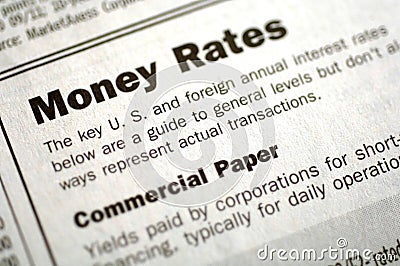
The world of fixed-income securities can be divided into two main
categories. The capital markets consist of securities with maturities of
more than 270 days, while the money market comprises all fixed-income instruments
that mature in 270 days or fewer. Commercial paper falls into the
latter category and is a common fixture in many money market mutual
funds. This short-term instrument can be a viable alternative for retail
fixed-income investors who are looking for a better rate of return on
their money.
Basic Characteristics
Commercial paper is an unsecured form of promissory note that pays a fixed rate of interest. It is typically issued by large banks or corporations to cover short-term receivables and meet short-term financial obligations, such as funding for a new project. As with any other type of bond or debt instrument, the issuing entity offers the paper assuming that it will be in a position to pay both interest and principal by maturity. It is seldom used as a funding vehicle for longer-term obligations because other alternatives are better suited for that purpose.
Commercial paper provides a convenient financing method because it allows issuers to avoid the hurdles and expense of applying for and securing continuous business loans, and the SEC does not require securities that trade in the money market to be registered. It is usually offered at a discount with maturities that can range from one to 270 days, although most issues mature in one to six months.
History of Commercial Paper
Commercial paper was first introduced over 100 years ago, when New York merchants began to sell their short-term obligations to dealers that acted as middlemen. These dealers would purchase the notes at a discount from their par value and then pass them on to banks or other investors. The borrower would then repay the investor an amount equal to the par value of the note.
Marcus Goldman of Goldman Sachs was the first dealer in the money market to purchase commercial paper, and his company became one of the biggest commercial paper dealers in America following the Civil War. The Federal Reserve also began trading commercial paper along with treasury bills from that time until World War II to raise or lower the level of monetary reserves circulating among banks.
After the war, commercial paper began to be issued by a growing number of companies, and eventually it became the premier debt instrument in the money market. Much of this growth was facilitated by the rise of the consumer credit industry, as many credit card issuers would provide cardholder facilities and services to merchants using money generated from commercial paper. The card issuers would then purchase the receivables placed on the cards by customers from these merchants (and make a substantial profit on the spread). A debate raged in the 1980s about whether banks were violating the Banking Act of 1933 by underwriting commercial paper, since it is not classified as a bond by the SEC. Today commercial paper stands as the chief source of short-term financing for investment-grade issuers along with commercial loans and is still used extensively in the credit card industry.
Commercial Paper Markets
Commercial paper has traditionally been issued and traded among institutions in denominations of $100,000, with notes exceeding this amount available in $1,000 increments. Financial conglomerates such as investment firms, banks and mutual funds have historically been the chief buyers in this market, and a limited secondary market for this paper exists within the banking industry.
Wealthy individual investors have also historically been able to access commercial paper offerings through a private placement. The market took a severe hit when Lehman Brothers declared bankruptcy in 2008, and new rules and restrictions on the type and amount of commercial paper that could be held inside money market mutual funds were instituted as a result. Nevertheless, these instruments are becoming increasingly available to retail investors through online outlets sponsored by financial subsidiaries.
Commercial paper usually pays a higher rate of interest than guaranteed instruments, and the rates tend to rise along with national economic growth. Some financial institutions even allow their customers to write checks and make transfers online with commercial paper fund accounts in the same manner as a cash or money market account. However, investors need to be aware that these notes are not FDIC-insured. They are backed solely by the financial strength of the issuer in the same manner as any other type of corporate bond or debenture. Standard &Poor’s and Moody’s both rate commercial paper on a regular basis using the same rating system as for corporate bonds, with AAA and Aaa being their highest respective ratings. As with any other type of debt investment, commercial paper offerings with lower ratings pay correspondingly higher rates of interest. But there is no junk market available, as commercial paper can only be offered by investment-grade companies.
Rates and Pricing
The Federal Reserve Board posts the current rates being paid by commercial paper on its website. The FRB also publishes the rates of AA-rated financial and non-financial commercial paper in its H.15 Statistical Release every Monday at 2:30pm. The data used for this publication are taken from the Depository Trust & Clearing Corporation (DTCC), and the rates are calculated based on the estimated relationship between the coupon rates of new issues and their maturities. Additional information on rates and trading volumes is available each day for the previous day’s activity. Figures for each outstanding commercial paper issue are also available at the close of business every Wednesday and on the last business day of every month.
The Bottom Line
Commercial paper is becoming increasingly available to retail investors from many outlets. Those who seek higher yields will likely find these instruments appealing due to their superior returns with modest risk. For more information on commercial paper, contact your financial advisor or visit the Federal Reserve Board website at www.federalreserve.gov
Basic Characteristics
Commercial paper is an unsecured form of promissory note that pays a fixed rate of interest. It is typically issued by large banks or corporations to cover short-term receivables and meet short-term financial obligations, such as funding for a new project. As with any other type of bond or debt instrument, the issuing entity offers the paper assuming that it will be in a position to pay both interest and principal by maturity. It is seldom used as a funding vehicle for longer-term obligations because other alternatives are better suited for that purpose.
Commercial paper provides a convenient financing method because it allows issuers to avoid the hurdles and expense of applying for and securing continuous business loans, and the SEC does not require securities that trade in the money market to be registered. It is usually offered at a discount with maturities that can range from one to 270 days, although most issues mature in one to six months.
History of Commercial Paper
Commercial paper was first introduced over 100 years ago, when New York merchants began to sell their short-term obligations to dealers that acted as middlemen. These dealers would purchase the notes at a discount from their par value and then pass them on to banks or other investors. The borrower would then repay the investor an amount equal to the par value of the note.
Marcus Goldman of Goldman Sachs was the first dealer in the money market to purchase commercial paper, and his company became one of the biggest commercial paper dealers in America following the Civil War. The Federal Reserve also began trading commercial paper along with treasury bills from that time until World War II to raise or lower the level of monetary reserves circulating among banks.
After the war, commercial paper began to be issued by a growing number of companies, and eventually it became the premier debt instrument in the money market. Much of this growth was facilitated by the rise of the consumer credit industry, as many credit card issuers would provide cardholder facilities and services to merchants using money generated from commercial paper. The card issuers would then purchase the receivables placed on the cards by customers from these merchants (and make a substantial profit on the spread). A debate raged in the 1980s about whether banks were violating the Banking Act of 1933 by underwriting commercial paper, since it is not classified as a bond by the SEC. Today commercial paper stands as the chief source of short-term financing for investment-grade issuers along with commercial loans and is still used extensively in the credit card industry.
Commercial Paper Markets
Commercial paper has traditionally been issued and traded among institutions in denominations of $100,000, with notes exceeding this amount available in $1,000 increments. Financial conglomerates such as investment firms, banks and mutual funds have historically been the chief buyers in this market, and a limited secondary market for this paper exists within the banking industry.
Wealthy individual investors have also historically been able to access commercial paper offerings through a private placement. The market took a severe hit when Lehman Brothers declared bankruptcy in 2008, and new rules and restrictions on the type and amount of commercial paper that could be held inside money market mutual funds were instituted as a result. Nevertheless, these instruments are becoming increasingly available to retail investors through online outlets sponsored by financial subsidiaries.
Commercial paper usually pays a higher rate of interest than guaranteed instruments, and the rates tend to rise along with national economic growth. Some financial institutions even allow their customers to write checks and make transfers online with commercial paper fund accounts in the same manner as a cash or money market account. However, investors need to be aware that these notes are not FDIC-insured. They are backed solely by the financial strength of the issuer in the same manner as any other type of corporate bond or debenture. Standard &Poor’s and Moody’s both rate commercial paper on a regular basis using the same rating system as for corporate bonds, with AAA and Aaa being their highest respective ratings. As with any other type of debt investment, commercial paper offerings with lower ratings pay correspondingly higher rates of interest. But there is no junk market available, as commercial paper can only be offered by investment-grade companies.
Rates and Pricing
The Federal Reserve Board posts the current rates being paid by commercial paper on its website. The FRB also publishes the rates of AA-rated financial and non-financial commercial paper in its H.15 Statistical Release every Monday at 2:30pm. The data used for this publication are taken from the Depository Trust & Clearing Corporation (DTCC), and the rates are calculated based on the estimated relationship between the coupon rates of new issues and their maturities. Additional information on rates and trading volumes is available each day for the previous day’s activity. Figures for each outstanding commercial paper issue are also available at the close of business every Wednesday and on the last business day of every month.
The Bottom Line
Commercial paper is becoming increasingly available to retail investors from many outlets. Those who seek higher yields will likely find these instruments appealing due to their superior returns with modest risk. For more information on commercial paper, contact your financial advisor or visit the Federal Reserve Board website at www.federalreserve.gov




